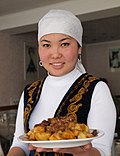Kyrgyz people: Difference between revisions
CSV import Tags: mobile edit mobile web edit |
CSV import |
||
| Line 31: | Line 31: | ||
{{Ethnic-group-stub}} | {{Ethnic-group-stub}} | ||
{{food-stub}} | {{food-stub}} | ||
<gallery> | |||
File:Ala-Bel_pass,_Kyrgyzstan_(29561433347).jpg|Ala-Bel Pass, Kyrgyzstan | |||
File:A_Kyrgyz_woman.JPG|A Kyrgyz woman | |||
File:YurtIssykFamily.jpg|Family in a yurt | |||
File:Kyrgyz_women_offering_butter_and_salt.jpg|Kyrgyz women offering butter and salt | |||
File:KyrgyzEagleHuntsman.jpg|Kyrgyz eagle huntsman | |||
File:Eurasian_genetic_PCA_centered_on_Central_Asians.jpg|Eurasian genetic PCA centered on Central Asians | |||
File:Mešita_v_Tokmoku.jpg|Mosque in Tokmok | |||
File:Kirghiz_Tents.png|Kirghiz tents | |||
File:CC-BY_icon.svg|Kyrgyz people | |||
</gallery> | |||
Latest revision as of 11:48, 18 February 2025
Kyrgyz people are a Turkic ethnic group native to Kyrgyzstan, as well as regions in China, Afghanistan, Pakistan, and Tajikistan. They are recognized for their rich cultural heritage, which includes a tradition of nomadic lifestyle, folklore, and music.
History[edit]
The history of the Kyrgyz people dates back to ancient times. They are believed to have descended from the Yenisei Kyrgyz, a Turkic group that lived in the upper Yenisei River region during the 1st millennium AD. The Yenisei Kyrgyz established a powerful khaganate that was noted in Chinese and Muslim geographical works.
Language[edit]
The Kyrgyz people speak Kyrgyz, a member of the Karluk branch of the Turkic language family. The language is closely related to Kazakh and, to a lesser extent, to Uzbek. The Kyrgyz language uses the Cyrillic script in Kyrgyzstan, while those in China use an Arabic script.
Culture[edit]
Kyrgyz culture is heavily influenced by their nomadic heritage. This is reflected in their yurts, a type of portable tent that has been a primary form of dwelling for the Kyrgyz for centuries. The Kyrgyz are also known for their epic poem, the Epic of Manas, which is one of the longest epic poems in the world.
Religion[edit]
The majority of Kyrgyz people practice Sunni Islam, which was introduced to the region by Arab traders and missionaries in the 8th century. However, elements of Tengrism, the traditional Turkic belief system, are still present in Kyrgyz religious practices.
Cuisine[edit]
Kyrgyz cuisine is a reflection of the nation's nomadic history and has been influenced by Turkic, Mongol, and Russian cuisines. Staple dishes include Beshbarmak, a boiled meat dish, and Kumis, a fermented dairy product made from mare's milk.
See also[edit]
This article is a ethnic-group stub. You can help WikiMD by expanding it!
-
Ala-Bel Pass, Kyrgyzstan
-
A Kyrgyz woman
-
Family in a yurt
-
Kyrgyz women offering butter and salt
-
Kyrgyz eagle huntsman
-
Eurasian genetic PCA centered on Central Asians
-
Mosque in Tokmok
-
Kirghiz tents
-
Kyrgyz people









